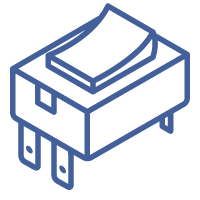
TE Connectivity 436024-1
436024-1
-
32284681-436024-1
Rotary Switches SW ASSY 3100 12 POS BCD COMP.
- Surface Mount
having leads that are designed to be soldered on the side of a circuit board that the body of the component is mounted on.
NO - Mounting TypePanel Mount, Through Hole
- Mounting Feature
a process by which the operating system makes files and directories on a storage device (such as hard drive, CD-ROM, or network share) available for users to access via the computer's file system.
SURFACE MOUNT-STRAIGHT - Actuator Material
In smart material system, actuator materials have the ability to change the shape, stiffness, position, natural frequency, damping and/or other mechanical characteristics of the smart material systems in response to changes in temperature, electric field and/or magnetic field.
THERMOPLASTIC - Center Contact PlatingGOLD OVER NICKEL
- Center Contact MaterialPHOSPHOR BRONZE
- End Contact MaterialPHOSPHOR BRONZE
- End Contact PlatingGOLD OVER NICKEL
- Risk Rank5.91
- ActuatorColorBLACK
- Manufacturer Part Number436024-1
- Rohs CodeNo
- Part Life Cycle CodeObsolete
- Ihs ManufacturerTE CONNECTIVITY LTD
- Operating Temperature-Max88 °C
- Operating Temperature-Min-18 °C
- Dielectric Withstand Volts500VDC V
- ElectricalLife25000 Cycle(s)
- Indexing Angle30 deg
- Insulator MaterialPOLYESTER
- Contact MaterialsPhosphor Bronze
- PackageTray
- Base Product Number436024
- MfrTE Connectivity ALCOSWITCH Switches
- Product StatusActive
- Series3100
- Part Status
Parts can have many statuses as they progress through the configuration, analysis, review, and approval stages.
Active - ECCN CodeEAR99
- Number of Positions12
- Additional Feature
Any Feature, including a modified Existing Feature, that is not an Existing Feature.
PANEL MOUNT-THREADED ALSO AVILABLE - HTS Code
HTS (Harmonized Tariff Schedule) codes are product classification codes between 8-1 digits. The first six digits are an HS code, and the countries of import assign the subsequent digits to provide additional classification. U.S. HTS codes are 1 digits and are administered by the U.S. International Trade Commission.
8536.50.90.20 - Current Rating (Amps)125mA (AC)
- Reach Compliance Codecompliant
- Current Rating
Current rating is the maximum current that a fuse will carry for an indefinite period without too much deterioration of the fuse element.
125mA (AC) - Contact FinishGold
- Termination StylePC Pin
- Body Length or Diameter30.48 mm
- Body Breadth28.58 mm
- Actuator TypeROTARY
- Brand NameAlcoswitch
- Switch Function
This function will evaluate a given expression (or a value) against a list of values and will return a result corresponding to the first matching value. In case there is no matching value, an optional default value will be returned.
BCD COMPLEMENT - Panel Cutout DimensionsCircular - 9.58mm Dia
- Contact Resistance0.15 mΩ
- Insulation Resistance
The measurement of insulation resistance is carried out by means of a megohmmeter – high resistance range ohmmeter. A general rule-of-thumb is 10 Megohm or more.
100000000 Ω - Contact Current(DC)-Max0.02 A
- Contact Voltage(DC)-Max20 V
- Termination TypeSOLDER
- Switch Type
Based on their characteristics, there are basically three types of switches: Linear switches, tactile switches and clicky switches.
ROTARY CODED SWITCH - Number of Decks1
- Operating Force5.761 ~ 23gfm
- Contact Current(AC)-Max0.125 A
- Contact (AC) Max Rating R Load
- Contact TimingQUICK-MAKE/-BREAK
- Contact (DC) Max Rating R Load
- Contact Voltage(AC)-Max115 V
- Index StopsContinuous
- Circuit per Deck
The number of poles per deck is the number of separate circuits that can be activated through a rotary switch per deck. The output connections are usually called ways instead of throws.
BCD Complement - Depth Behind Panel13.34mm
- Number of Switch Sections1
- Number of Poles per Deck
The number of poles per deck is the number of separate circuits that can be activated through a rotary switch per deck. The output connections are usually called ways instead of throws.
-- - Angle of Throw30°
- PCB Hole Count2
- Switch ActionLATCHED
- Body ColorBLACK
- Features--
- Body Height11.99 mm
- Actuator Length14.88mm








